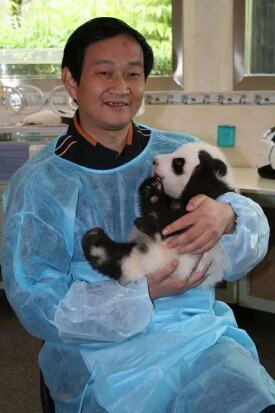魏輔文
魏輔文
魏輔文,男,1964年4月生於重慶市雲陽縣,籍貫重慶雲陽,保護生物學家,中國科學院院士、發展中國家科學院院士,中國科學院動物研究所研究員、博士生導師。1984年和1987年在西華師範大學分別獲得學士和碩士學位,1997年獲中國科學院動物研究所博士學位。主要從事大熊貓、小熊貓等瀕危動物保護生物學研究。
魏輔文院士長期從事瀕危動物保護生物學研究,圍繞物種瀕危和適應性演化機制科學難題,以大熊貓為研究模型,取得系列重大突破性進展,是國際上瀕危動物保護基因組學和宏基因組學研究的主要開拓者。重建了大熊貓的種群歷史,闡明其瀕危過程和原因,發現其仍具演化潛力;從形態、行為、生理、遺傳和腸道微生物等方面系統揭示了大熊貓在食性轉換和特化歷程中適應性演化的機制,發現其對竹子已產生一系列適應,得到國際同行的高度認可;闡明了大熊貓孤立小種群崩潰的生態與遺傳機制,推動了國家大熊貓放歸和棲息地廊道建設工程的實施;發現大熊貓及其棲息地的生態系統服務價值遠高於保護投入。為我國生態文明建設和瀕危動物保護做出基礎性和應用性的貢獻!

魏輔文
1987年—1997年,西華師範大學珍稀動植物資源研究所從事大熊貓、小熊貓等珍稀動物的研究工作(其間,1988年晉陞為助理研究員,1992年晉陞為副研究員;1994年至1997年,在中國科學院動物研究所動物生態專業全日制博士研究生學習,獲博士學位);
1997年—今,中科院動物研究所所工作。現為動物生態與保護生物學院重點實驗室主任,動物生態與保護遺傳學研究組組長,曾任中國科學院動物研究所副所長。2017年當選為中國科學院院士,2018年11月當選發展中國家科學院院士。
主要從事瀕危動物保護生物學研究。率先將種群基因組學和宏基因組學等新技術引入到大熊貓研究中,闡明了大熊貓的種群歷史、瀕危過程及演化潛力。揭示了大熊貓在食性轉換和特化歷程中如何在形態、行為、生理、遺傳和腸道微生物等方面產生適應性演化的規律。闡明了棲息地破碎化導致大熊貓孤立小種群崩潰的機制,推動了國家大熊貓放歸和棲息地廊道建設工程的實施。重要代表性研究成果分別發表在 等期刊上,得到 等著名雜誌和 頻道、BBC、路透社等知名媒體廣泛報道和評述。
科技部973計劃項目:
中國-喜馬拉雅地區生物多樣性演變和保護研究專題——物種瀕危機制與保護對策(2007-2010)
國家基金委國際重大合作項目:青藏高原東北緣5大山系哺乳動物分佈格局及其形成機制(2007-2009)
國家自然科學基金重點項目:生境破碎化對金絲猴生存、繁衍的影響及其適應機制的研究(2007-2010)
美國聖地亞哥動物協會國際合作項目:秦嶺大熊貓生態學研究(2007-2009)
國際合作項目:圈養大熊貓的個體標記(2007-2009)
美國大自然協會國際合作項目:雲南老君山滇金絲猴生態和保護(2003-2006)
國家自然科學基金重點項目:瀕危獸類生境適宜性生態學基礎研究(2003-2006)
國家傑出青年基金項目:中國珍稀瀕危動物保護生物學研究(2002-2004)
目前主要承擔國家自然基金委重點項目和國家重點研發計劃“典型脆弱生態系統修復與保護研究”重點專項“珍稀動物瀕危機制及保護技術研究”項目等。
保護基因組學、保護遺傳學、保護生態學、保護行為學。
中華人民共和國瀕危物種科學委員會副主任、中國動物學會副理事長、獸類學分會理事長、中國生態學會副理事長、國際保護生物學會中國分會主席、世界獸類學家聯合會執委;Conservation Biology亞洲區域編輯,Proceedings of the Royal Society B, Integrative Zoology,Current Zoology,獸類學報、動物學研究等刊物編委;IUCN物種生存委員會熊類專家組成員;國家林業局第四次大熊貓調查專家委員會主任委員,國家林業局第二次陸生野生動物調查專家委員會主任委員,陝西省林業科學院秦嶺大熊貓研究中心學術委員會主任。

魏輔文
2002年享受國務院政府津貼;
2004入選人事部新世紀百千萬人才工程;
2009年被科技部評為野外科技工作先進個人;
2012年被中國科協評為全國優秀科技工作者;
2017年11月,當選為中國科學院(生命科學和醫學學部)院士;
2018年11月,當選為發展中國家科學院(TWAS)院士。
2019年1月17日,魏輔文院士榮獲中國科學院2018年度傑出科技成就獎。
2017年4月14日晚,2017年菠蘿科學獎頒獎典禮在浙江科技館舉行。中國科學院動物研究所魏輔文團隊的“為了吃,大小熊貓都進化出了六指”獲得生物醫學獎。
先後主持完成國家傑出青年基金、國際重大合作項目、國家基金重點項目、中國科學院知識創新重要方向性項目等,帶領團隊在Nature Genetics, PNAS, Current Biology, Molecular Biology and Evolution, Molecular Ecology, Conservation Biology, Molecular Phylogenetics and Evolution,Journal of Mammalogy, Biology Letter, Journal of Wildlife Management等刊物發表論文60多篇。2006年有關大熊貓分子生態學的研究成果在Current Biology上作為封面文章發表,Nature、Science等著名雜誌和Discovery頻道、BBC、路透社等多家知名媒體均在顯要位置發表相關的評論和報道,併入選2006年度美國Discover雜誌12大生物科技新聞;2007年在Molecular Biology and Evolution上發表有關大熊貓是否走到進化盡頭的文章再次引起媒體的廣泛關注,入選“2007年度中國基礎研究十大新聞”。2010年,有關小相嶺山系大熊貓棲息地喪失與破碎化對該地區大熊貓種群生存威脅的文章發表在Conservation Biology上,Science在Random Samples欄目發表了“野生熊貓的希望”文章,對該項工作進行了報道和評價。2011年,有關大熊貓腸道菌群幫助消化纖維素和半纖維素的工作在PNAS上,Nature等媒體對此做了報道和評價;大熊貓喜歡原始林的研究成果發表在Biology Letters,引起Nature和Science等媒體的高度關注。2012年,應邀在Molecular Ecology撰寫大熊貓遺傳學研究綜述。2013年,利用種群基因組學方法揭示了大熊貓種群歷史和適應相關成果,在Nature Genetics上以封面文章發表,Science Daily等媒體進行了報道。
1.Hu YB, Wu Q, Ma S, Ma TX, Shan L, Wang X, Nie YG, Ning ZM, Yan L, Xiu YF, Wei FW*. 2017. Comparative genomics reveals convergent evolution between the bamboo-eating giant and red pandas.Proceedings of the National Academy of Sciences of the United States of America, 114(5):1081–1086.
2.Nie YG, Speakman JR, Wu Q, Zhang CL, Hu YB, Xia MH, Yan L, Hambly C, Wang L, Wei W, Zhang JG, Wei FW*. 2015. Exceptionally low daily energy expenditure in the bamboo-eating giant panda. Science, 349(6244):171-174.
3. Wei FW*, Wang X, Wu Q. 2015. The giant panda gut microbiome. 2015.Trends in Microbiology, 23(8):450-452.
4. Wei FW*, Swaisgood RR, Hu YB, Nie YG, Yan L, Zhang ZJ, Qi DW, Zhu LF. 2015. Progress in the ecology and conservation of giant pandas.Conservation Biology, DOI: 10.1111/cobi.12582.
5. Wei FW*, Hu YB, Yan L, Nie YG, Wu Q, Zhang ZJ. 2014. Giant pandas are not an evolutionary cul-de-sac: evidence from multidisciplinary research.Molecular Biology and Evolution, doi: 10.1093/molbev/msu278.
6.Shan L, Hu YB, Zhu LF, Yan L, Wang CD, Li DS, Jin XL, Zhang CL, Wei FW*. 2014. Large-scale genetic survey provides insights into the captive management and reintroduction of giant pandas.Molecular Biology and Evolution,31:2663-26.
7.Nie YG, Zhang ZJ, Raubenheimer D, Elser J, Wei W, Wei FW*. 2014. Obligate herbivory in an ancestrally carnivorous lineage: the giant panda and bamboo from the perspective of nutritional geometry.Functional Ecology,doi: 10.1111/1365-2435.12302.
8.Zhang L, Wu Q, Hu YB, Wu H, Wei FW*. 2014. Major histocompatibility complex alleles associated with parasite susceptibility in wild giant pandas. Heredity, doi:10.1038/hdy.2014.73.
9.Wu Q, Zheng PP, Hu YB, Wei FW*. 2014. Genome-scale analysis of demographic history and adaptive selection.Protein Cell, 5:99-112.
10.Zhu LF, Hu YB, Qi DW, Wu H, Zhan XJ, Zhang ZJ, Bruford MW, Wang JL, Yang XY, Gu XD, Zhang L, Zhang BW, Zhang SN, Wei FW*. 2013. Genetic consequences of historical anthropogenic and ecological events on giant pandas. Ecology, 94: 2346-2357.
11.Zhao SC, Zheng PP, Dong SS, Zhan XJ, Wu Q, Guo XS, Hu YB, He WM, Zhang SN, Fan W, Zhu LF, Li D, Zhang XM, Chen Q, Zhang HM, Zhang ZH, Jin XL, Zhang JG, Yang HM, Wang J, Wang J, Wei FW*. 2013. Whole genome sequencing of giant pandas provides insights into demographic history and local adaptation.Nature Genetics, 45:67-71.
12.Zhu LF, Wu Q, Dai JY, Zhang SN, Wei FW*. 2011. Evidence of cellulose metabolism by the giant panda gut microbiome.Proceedings of the National Academy of Sciences of the United States of America, 108(43): 17714-17719.
13.Zhan XJ, Li M, Zhang ZJ, Goossens B, Chen YP, Wang HJ, Bruford MW, Wei FW*. 2006. Molecular censusing doubles giant panda population estimate in a key nature reserve.Current Biology, 16: R451-452.
14.Zhang BW, Li M, Zhang ZJ, Goossens B, Zhu LF, Zhang SN, Hu JC, Bruford MW, Wei FW*. 2007. Genetic viability and population history of the giant panda, putting an end to the evolutionary dead end?Molecular Biology and Evolution, 24:1801–1810.
15. Wei FW*, Hu YB, Zhu LF, Bruford MW, Zhan XJ, Zhang L. 2012. Black and white and read all over: the past, present and future of giant panda genetics.Molecular Ecology, 21:5660-5674.
16.Zhu LF, Zhang SN, Gu XD, Wei FW*. 2011. Significant genetic boundaries and spatial dynamics of giant pandas occupying fragmented habitat across southwest China.Molecular Ecology, 20:1122–1132.
17.Hu YB, Guo Y, Qi DW, Zhan XJ, Wu H, Bruford MW, Wei FW*. 2011. Genetic structuring and recent demographic history of red pandas (Ailurus fulgens) inferred from microsatellite and mitochondrial DNA.Molecular Ecology, 20: 2662–2675.
18.Zhan XJ, Zhang ZJ, Wu H, Goossens B, Li M, Jiang SW, Bruford MW, Wei FW*. 2007. Molecular analysis of dispersal in giant pandas.Molecular Ecology, 16:3792-3800.
19.Zhu LF, Zhan XJ, Wu H, Zhang SN, Meng T, Bruford MW, Wei FW*. 2010. Drastic reduction of the smallest and most isolated giant panda population: implications for conservation.Conservation Biology, 24: 1299–1306.
20.Li RQ, Fan W, Tian G, Zhu HM, He L, Cai J,…..., Wei FW,……Wang J, Wang J. 2010. The sequence and de novo assembly of the giant panda genome.Nature, 463:311-317.
21.Nie YG, Swaisgood RR, Zhang ZJ, Hu YB, Ma YS, Wei FW*. 2012. Giant panda scent-marking strategies in the wild: role of season, sex and marking surface.Animal Behaviour, 84:39-44.
22.Nie YG, Swaisgood R, Zhang ZJ, Liu XB, Wei FW*.2012. Reproductive competition and fecal testosterone in wild male giant pandas (Ailuropoda melanoleuca).Behavioral Ecology and Sociobiology, 66:721-730.
23.Nie YG, Zhang ZJ, R. Swisgood, Wei FW*. 2012. Effects of season and social interaction on fecal testosterone metabolites in wild male giant pandas: implications for energetics and mating strategies.European Journal of Wildlife Research, 58(1):235-241.
24.Qi DW, Zhang ZJ, Hu YB, Yang XY, Wang HJ, Wei FW*. 2012. Measures of giant panda habitat selection across multiple spatial scales for species conservation.Journal of Wildlife Management, 76:1092-1100.
25.Qi DW, Hu YB, Gu XD, Yang XY, Yang G, Wei FW*. 2012. Quantifying landscape linkages among giant panda subpopulations in regional scale conservation.Integrative Zoology, 7:165-174.
26.Zhang L, Yang XY, Wu H, Gu XD, Hu YB, Wei FW*. 2011. The parasites of giant pandas: individual-based measurement in wild animals.Journal of Wildlife Diseases, 47:164-71.
27.Guo Y, Hu YB, Qi DW, Zhan XJ, Bruford MW, Wei FW*. 2011 Genotyping faeces of red pandas (Ailurus fulgens): implications for population estimation.European Journal of Wildlife Research, 57:1231–1235.
28.Zhang ZJ, Swaisgood R, Zhang SN, Nordstrom LA, Wang HJ, Gu XD, Hu JC, Wei FW*. 2011. Old-growth forest is what giant pandas really need.Biology Letters, 7: 403-406.
29.Qi DW, Zhang SN, Zhang ZJ, YB Hu, Yang XY, Wang HJ, Wei FW*. 2011. Different habitat preferences of male and female giant pandas.Journal of Zoology, London, 285:205-214.
30.Zhu LF, Zhan XJ, Meng T, Zhang SN, Wei FW*. 2010. Landscape features influence gene flow as measured by cost-distance and genetic analyses: a case study for giant pandas in the Daxiangling and Xiaoxiangling Mountains.BMC Genetics, 11:72.
31.Hu YB, Qi DW, Wang HJ, Wei FW*. 2010. Genetic evidence of recent population contraction in the southernmost population of giant pandas.Genetica, 138:1297–1306.
32.Hu YB, Zhan XJ, Qi DW, Wei FW*. 2010. Spatial genetic structure and dispersal of giant pandas on a mountain-range scale.Conservation Genetics, 11:2145-2155.
33.Swaisgood RR, Wei FW, Wildt DE, Kouba AJ, Zhang ZJ. 2010. Giant panda conservation science: How far we have come.Biology Letters, 6:143-145.
34.Feng TT, Van Manen FT, Zhao NX, Li M, Wei FW*. 2009. Habitat assessment for giant pandas in the Qinling mountain region of China.Journal of Wildlife Management, 73:852–858.
35.Zhang ZJ, Zhan XJ, Yan L, Li M, Hu JC, Wei FW*. 2009. What determines selection and abandonment of a foraging patch by wild giant pandas (Ailuropoda melanoleuca) in winter?Environmental Science and Pollution Research, 16:79-84.
36.Qi DW, Hu YB, Gu XD, Li M, Wei FW. 2009. Ecological niche modeling of the sympatric giant and red pandas on a mountain-range scale.Biodiversity and Conservation, 18:2127–2141.
37.Zhan XJ, Zheng XD, Bruford BW, Wei FW, Tao Y. 2009. A new method for quantifying genotyping errors for noninvasive genetic studies.Conservation Genetics, 11:1567-1571.
38.Zhan XJ, Tao Y., Li M, Zhang ZJ, Goossens B, Chen YP, Wang HJ, Bruford MW, Wei FW. 2009. Accurate population size estimates are vital parameters for conserving the giant panda.Ursus, 20:56-62.
39.Wu H, Zhan XJ, Zhang ZJ, Zhu LF, Yan L, Li M, Wei FW*. 2009. Thirty-three microsatellite loci for noninvasive genetic studies of the giant panda (Ailuropoda melanoleuca).Conservation Genetics, 10:649-652.
40.Zhang ZJ, Swaisgood RR, Wu H, Li M, Yong YG, Hu JC, Wei FW. 2007. Factors predicting den use by maternal giant pandas.Journal of Wildlife Management, 71:2694–2698.
41.Zhang SN, Pan RL, Li M, Oxnard C, Wei FW*. 2007. Mandible of the giant panda (Ailuropoda melanoleuca) compared with other Chinese carnivores: functional adaptation.Biological Journal of the Linnean Society, 92:449-456.
42.Zhang ZJ, Wei FW, Li M, Hu JC. 2006. Winter microhabitat separation between giant and red pandas inBashania faberibamboo forest in Fengtongzhai Nature Reserve.Journal of Wildlife Management, 70:231-235.
43.Zhang BW, Li M, Ma LC, Wei FW*. 2006. A widely applicable protocol for DNA isolation from fecal samples.Biochemical Genetics, 44:503-511.
